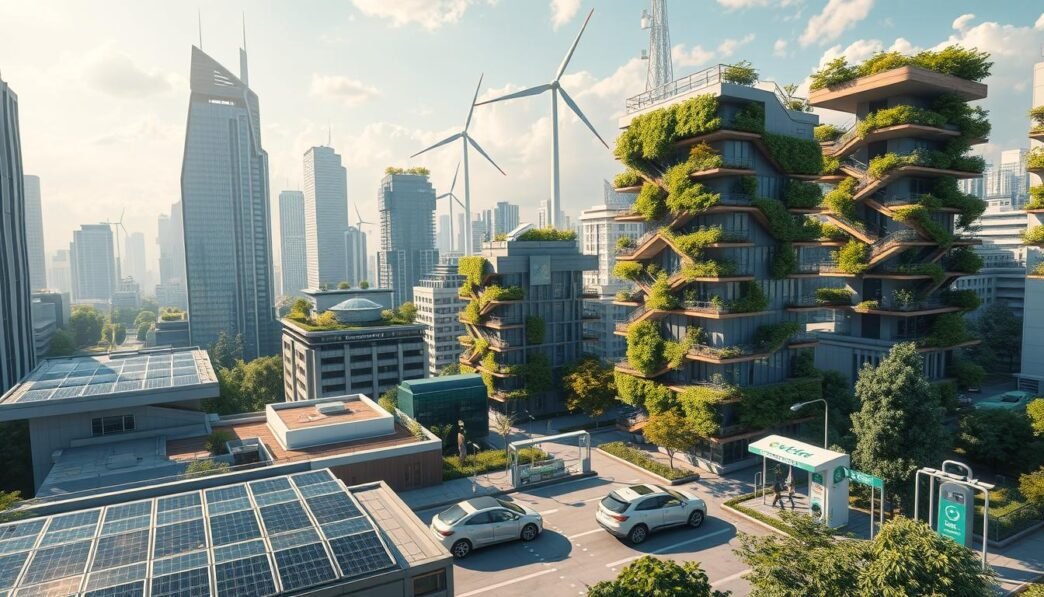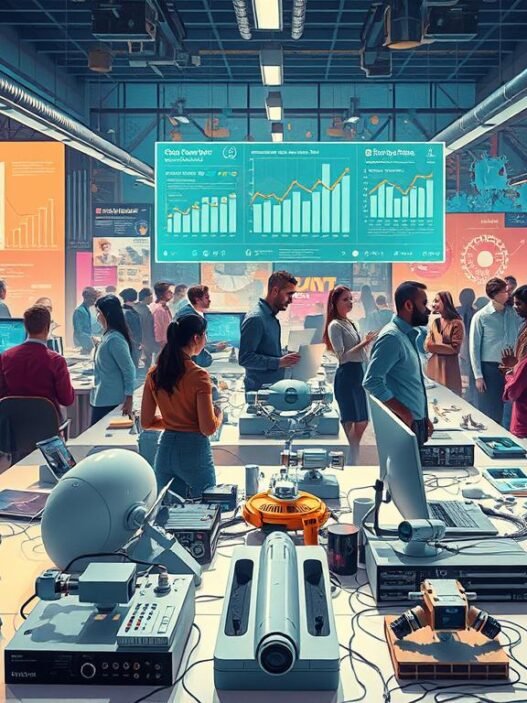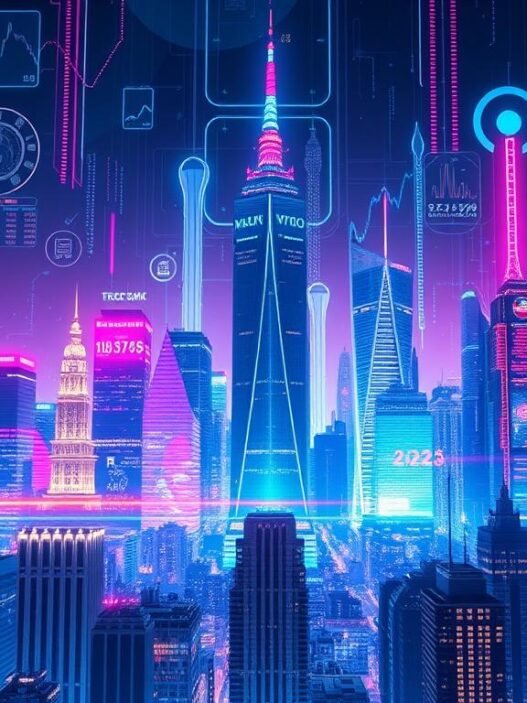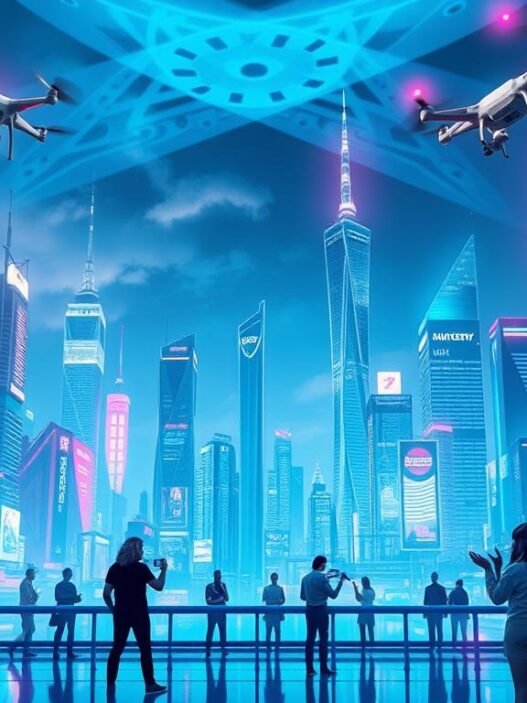Did you know the International Air Transport Association (IATA) believes Sustainable Aviation Fuel (SAF) could cut aviation’s carbon footprint by up to 80%? This shows how close we are to solving climate change. Green tech innovations are key in our battle to save the planet from rising temperatures, extreme weather, and loss of biodiversity.
The World Intellectual Property Organization (WIPO) says 80% of the tech needed for 2030’s climate goals already exists. From energy-saving gadgets to clean energy sources, these technological advances redefine our relationship with the Earth. They make us more resilient, less vulnerable, and promise a brighter future for all.
UN Secretary-General António Guterres made it clear in 2021 that we’re at a critical point. But there’s hope through green tech innovations. They show us that a world that respects the environment is within our reach, if we all work together. Explore how these technologies are leading us to a more sustainable world, and marvel at the amazing progress in green tech.
Key Takeaways
- The IATA suggests SAF can reduce aviation’s fuel carbon footprint by up to 80%, showcasing significant potential in climate change solutions.
- WIPO claims that 80% of necessary technologies to meet 2030 climate goals are already available.
- Solar power, currently used by 3.7% of US homes, is becoming more cost-effective and efficient.
- Breakthroughs in green building technologies, such as electrochromic glass in HVAC systems, are reducing energy consumption and environmental impact.
- Renewable energy sources and energy-efficient devices play crucial roles in the advancements in environmental technology.
Understanding Green Technology
Green technology is key to sustainable development and protecting our environment. It uses renewable resources and smart designs. This helps reduce the harm we do to our planet.
Definition of Green Technology
Green technology involves various materials, techniques, and methods. It aims to save natural resources and cut down on pollution. It focuses on using renewable resources and creating less waste. The field covers renewable energy, eco-friendly materials, and turning waste into energy.
Importance of Sustainability
Sustainable development is vital. It lets us meet our needs without stopping future generations from meeting theirs. At its core, it calls for using resources wisely and lowering our carbon footprint. The Infrastructure Investment and Jobs Act, with $1.2 trillion funds, supports green tech. It highlights the importance of clean energy and electric cars for managing global resources.
Types of Green Technologies
Green technologies come in many forms to solve different environmental issues. Let’s look at some key types:
| Type of Green Technology | Description |
|---|---|
| Renewable Energy | Includes solar, wind, and hydropower solutions that harness natural sources to generate electricity without depleting resources. |
| Waste-to-Energy | Processes that convert non-recyclable waste material into usable heat, electricity, or fuel, promoting waste reduction and sustainable energy production. |
| Eco-friendly Materials | Utilizes sustainable materials like bamboo, hemp, and straw in construction to reduce carbon footprints and promote energy-efficient buildings. |
| Sustainable Agriculture | Practices that prioritize natural resource conservation, such as crop rotation, organic farming, and water-efficient irrigation systems. |
Green technology has many uses that move us towards sustainable living. By using renewable resources and focusing on conservation, we’re building a green and strong future.
Renewable Energy Sources
Renewable energy is becoming more popular as we aim for cleaner energy. Fossil fuels are a big problem because they cause most of the world’s greenhouse gas emissions. That’s why we need things like solar power, wind energy, and hydropower.
Solar Power
Solar power has become much cheaper. From 2010 to 2020, the cost of solar electricity dropped by 85 percent. This made solar panels a top choice for both homes and businesses. By 2025, the U.S. will increase its solar energy use by 75 percent. This shows how important solar power is in our energy plans.
Wind Energy
Wind energy is growing thanks to more investment in turbines and farms. The costs for wind energy have gone down a lot in the last ten years. With new technology, the U.S. will produce 11 percent more wind energy by 2025. Wind turbines are great for making a lot of electricity for the grid.
Hydropower
Hydropower is a key player in renewable energy. It offers a steady and large amount of power. It’s an important part of a balanced energy mix. This ensures we have reliable electricity. Adding solar and wind to hydropower means we’re on track. Experts believe 90 percent of our electricity could be renewable by 2050, says the International Renewable Energy Agency (IRENA).
Putting money into renewable energy is good for the planet and the economy. Currently, 29 percent of our electricity is renewable. There’s a lot of room for growth. As clean energy evolves, it will create jobs and cut costs linked to pollution. This leads to a sustainable and thriving future for everyone.
Carbon Capture, Utilization, and Storage (CCUS)
Carbon Capture, Utilization, and Storage, or CCUS, is key in fighting climate change. It captures CO2 from places like factories, helping us reduce emissions. By doing this, CCUS plays a big part in cleaning our air and finding use for the carbon captured.

How CCUS Works
CCUS technology captures CO2 from processes like making cement or steel, and power generation. This CO2 is then sent through pipelines to be stored underground in rock formations. This helps a lot in cutting down emissions.
Besides storing, the captured CO2 can also be used in different industries. It helps in things like oil recovery, making carbon fiber, and producing concrete. CCUS gives us the best of both worlds: helping industries reduce carbon while offering resources for other uses.
Current CCUS Projects
Interest in CCUS projects is growing globally. As of 2022, there are 30 CCUS projects running, 11 being built, and 153 being planned. The US is leading with the most projects, showing a strong commitment to reduce CO2 and promote sustainability.
For example, the Net Zero Teesside Power project in the UK aims to capture two million tonnes of CO2 annually. This is enough to serve 1.3 million homes. The project shows how powerful CCUS can be in reducing emissions on a large scale. The Canopy by T.EN™ with Shell CANSOLV® CO2 capture system also shows advanced CO2 management.
Using industrial know-how can make CCUS projects more affordable. With the CO2 capture capacity growing to 244 million tonnes per year in 2022, CCUS is essential for reaching net-zero emissions by 2050. This is a 44% increase from the previous year, highlighting CCUS’s role in our climate goals.
| Region | Number of Projects |
|---|---|
| Americas | 94 (80 in the U.S.) |
| Europe | 73 (27 in the UK) |
| Asia-Pacific | 21 |
| Middle East | 6 |
With a goal to decarbonize and hit net-zero by 2050, CCUS projects are crucial. They show how important and effective CCUS is for a sustainable and low-carbon future. Our global efforts and progress in CCUS are helping us move in the right direction.
Green Building and Architecture
Green building and architecture play a crucial role in tackling the environmental effects of construction. The building sector uses about 40% of the nation’s energy and 75% of its electricity. Sustainable construction aims to lower carbon emissions, helping fight climate change.
Elements of Green Building
Sustainable construction uses various elements to be resource-efficient and eco-friendly. Important parts include:
- Utilization of renewable energy
- Effective water management systems
- Use of recycled and sustainable materials
- Energy-efficient lighting and HVAC systems
- LEED certification standards
Examples of Sustainable Architecture
Many famous buildings use sustainable construction principles, like using renewable energy and efficient land use:
| Building Name | Location | Features |
|---|---|---|
| Bosco Verticale | Milan, Italy | Incorporates dense vegetation to improve air quality and aesthetics |
| Apple Park | Cupertino, USA | Features extensive solar panels and green spaces |
Benefits of Green Buildings
Green buildings have many benefits, for the environment and economically. For example, buildings with LEED certification emit 50% less greenhouse gases than standard ones. Other advantages are:
- 20% reduction in maintenance costs
- Higher property values (16% higher resale value)
- Increased rental income from better occupancy rates
- Improved employee performance and health for occupants
Even though green buildings cost more at first, they offer great savings opportunities. They can reduce daily operating costs by up to 10% each year. This promotes lasting sustainability.
Electric Vehicles (EVs)
Electric vehicles (EVs) are changing the automotive industry by promoting no-emission transport. Key car makers like General Motors aim to end sales of new gasoline cars by 2035. Volvo plans to have an all-electric lineup by 2030. This move towards electric cars is crucial for sustainable mobility.
Advantages of EVs
Electric vehicles have many benefits. First, they emit way fewer greenhouse gases than gasoline vehicles. Although making EVs creates more emissions because of their batteries, their electric motors are more efficient. Plus, EVs have no tailpipe emissions, leading to cleaner air and less health risks.
Electric vs. Traditional Vehicles
Comparing EVs to traditional vehicles brings up several key points. EVs are more fuel-efficient, with some getting over 130 MPGe. They need 25–40 kWh of electricity to go 100 miles. The U.S. power mix, including fossil fuels and renewables, generally makes EVs greener than ordinary cars.
Also, EVs remove the need for gasoline. In 2022, the U.S. imported 8.32 million barrels of oil a day for gasoline. This is a huge advantage for EVs.
| Aspect | Electric Vehicles | Traditional Vehicles |
|---|---|---|
| Emissions | Zero tailpipe emissions | Significant tailpipe emissions |
| Efficiency | 130 MPGe | 20-30 MPG |
| Cost Over Time | Lower fuel costs, declining battery prices | Higher fuel costs |
| Maintenance | Lower due to fewer moving parts | Higher due to complex engine parts |
Future of Electric Vehicles
The future of electric vehicles looks bright. The growth of charging stations across the U.S. supports more electric cars. As of 2023, there are over 53,000 public charging stations. These have more than 137,000 ports.
Models predict EV batteries will last between 12 to 15 years in moderate climates. Makers offer 8-year/100,000-mile warranties for these batteries. As technology advances and production increases, battery costs will go down. MIT researchers have created tools to study the climate effects of different cars. This highlights the significance of choosing sustainably.
Vertical Farming Innovations
Vertical farming is changing urban agriculture around the world. It’s a method where crops grow in vertically stacked layers. This innovative way is transforming how we create food and tackle food security.
This method uses up to 70% less water than traditional farming. It also doesn’t need pesticides, making it eco-friendly. Aeroponics, a form of vertical farming, uses 90% less water than efficient hydroponics.
AeroFarms leads in vertical farming with its high-tech approach. They focus on growing more crops in less space, which changes how we think about producing food.
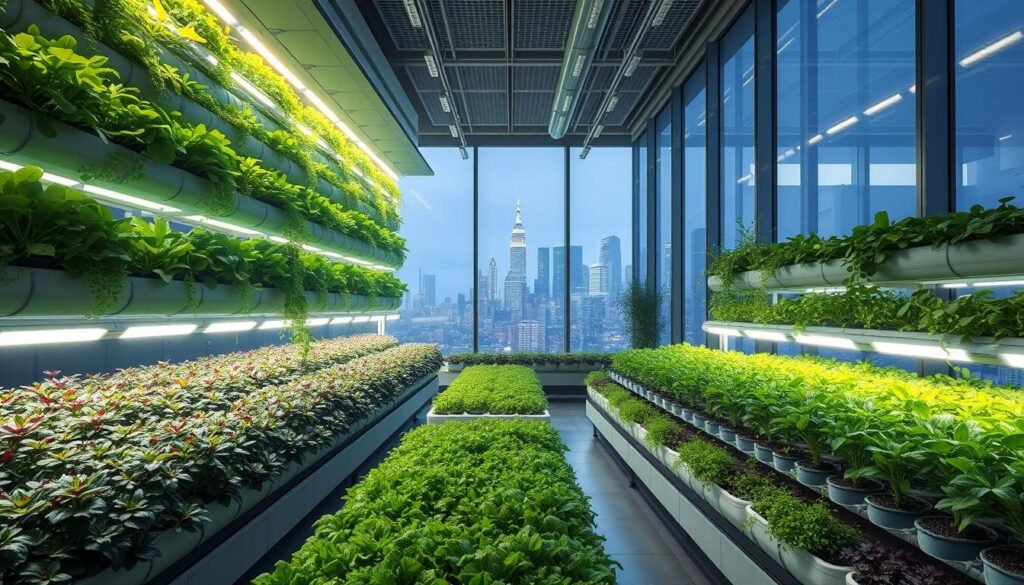
VertiCrop yields up to twenty times more than fields, using only 8% of the water. Modular Farms creates customizable options to grow fresh plants all year, in any weather.
- Asia, the Middle East, and Africa are seeing a rise in vertical farming, thanks to urban growth and tech progress.
- Cubic Farms uses automation and LED lights to create perfect conditions, using much less water.
- Companies are investing more in research to grow different kinds of crops, like Freight Farms does with lettuce, herbs, and flowers.
Besides improving food security in cities, vertical farming helps with biodiversity. It uses less land, which supports more sustainable agriculture.
New technology in biotech, materials science, and green energy will make vertical farming even better. North America is seeing more startups, while countries like the Netherlands, Germany, and the UK invest in urban farming.
Finally, partnerships between container farms and remote communities are boosting food security. This means city dwellers in Africa can enjoy fresh, local veggies all year.
Energy-Efficient Devices
The move towards energy-efficient devices is a big step in lowering our global carbon footprint. Thanks to new technology in low-power electronics and more smart tech, we now have many green gadgets. These gadgets work better and use less energy.
Examples of Energy-Efficient Devices
Energy-efficient devices come in many kinds, like home appliances and electronics. LED bulbs, for example, last much longer than CFLs and traditional bulbs. They use up to 90 percent less energy for the same light, which makes them key for saving energy at home.
Efficient washing machines use 25 percent less energy and 40 percent less water than standard ones. Similarly, new refrigerators have better insulation and compressors to save energy. Efficient air conditioners are also made to work better, helping to save more energy.
In electronics, we see energy-saving designs in laptops, tablets, and smartphones. They don’t sacrifice performance for efficiency. Smart tech, like smart thermostats and home systems, also helps save energy by automating it.
Impact on Sustainability
Using energy-efficient gadgets greatly helps sustainability. By choosing these devices, people can use less energy. This not only lowers energy bills but also helps meet big environmental goals by reducing our digital carbon footprint.
Devices like energy-saving dehumidifiers and dishwashers that use less water are making living more sustainable. They optimize how they run to use less energy and water. This approach is changing how we live for the better.
Now, the focus is also on making electronics more sustainably. This means making sure they are efficient, use renewable energy, reduce waste, and use sustainable materials. By doing this, we support a move towards a greener economy and create jobs in green energy and sustainable design.
| Device | Energy Efficiency | Impact |
|---|---|---|
| LED Bulbs | Up to 90% less energy than incandescent bulbs | Lasts up to 25 times longer, reducing replacement frequency |
| Efficient Clothes Washers | 25% less energy, 40% less water | Decreases utility bills and water usage |
| Efficient Refrigerators | Improved insulation and compressors | Reduces overall energy consumption |
| Energy-Efficient Dehumidifiers | 15% less energy than conventional models | Optimizes energy use |
| Advanced Dishwashers | Adjusts cycles, improves filtration | Lower water and energy consumption |
Sustainable Technology
Sustainable technology shapes the environment and changes how businesses work and how people shop. Companies that go green are now more popular, mixing tech with eco-friendly habits for better outcomes. This mix helps both the planet and the economy.
Impact on Business Models
The move to green tech changes how companies operate. By using technology, businesses can track their environmental impact. They look at things like energy use, carbon emissions, and water use. Reporting these things is now a must in places like the EU.
This tech also helps companies focus on recycling and reusing, cutting down waste. It leads to smarter business that can handle changes and problems better. For example, smart tech helps manage buildings efficiently, saving more energy.
Consumer Adoption
More shoppers want to buy from green companies. Especially millennials, who strongly prefer to support or work for these businesses. As a result, eco-friendly products are becoming a top choice for many.
Products designed with the planet in mind are in demand. Tools that help companies be more eco-friendly are crucial. This helps them reduce their carbon footprint. Meeting this demand is key for businesses aiming to embrace sustainable tech.
To better understand the impacts, consider the following insights:
| Aspect | Statistics |
|---|---|
| CEO acknowledgment of investor demand for sustainability. | 60% |
| Product-related environmental impacts determined during design phase. | Over 80% |
| Businesses using sustainability to improve production and innovation. | 48% |
| Millennials wanting to work for eco-friendly businesses. | 75% |
The growth of sustainable technology in businesses and among consumers is changing our future. Green habits and advanced tech are shaping a new normal. This movement is driven by the demand for a cleaner, more sustainable world.
Sustainable E-Waste Management
As more people use electronic devices, managing e-waste becomes crucial to prevent pollution and save resources. Electronics often contain harmful materials like lead and mercury. These can harm both our planet and our health. Yet, embracing new recycling programs and supporting eco-friendly disposal can reduce e-waste’s impact.
Importance of Recycling E-Waste
Recycling e-waste helps recover valuable resources and lessen harmful disposal effects. Programs where producers are responsible for their products’ life cycle can help. Plus, using blockchain technology can make the recycling process more transparent. These efforts not only support a circular economy but also encourage us to dispose of electronics responsibly.
Current E-Waste Recycling Practices
Today, various methods are improving e-waste recycling. Techniques like automated sorting and eco-friendly extraction are key for good resource recovery. In Lagos State, over 104 recycling companies and 6,000 informal recyclers help manage e-waste. But in places like the UK, only 20% of e-waste is recycled yearly. This shows we need more recycling programs and awareness.
Global cooperation and better policies are required to tackle e-waste effectively. The 2022 “National Environmental (Electrical/Electronic Sector) Regulation” in Nigeria is a good policy example. It bans importing e-waste. By adopting new recycling tech, educating consumers, and improving laws, we can handle e-waste sustainably and protect our environment for the future.






